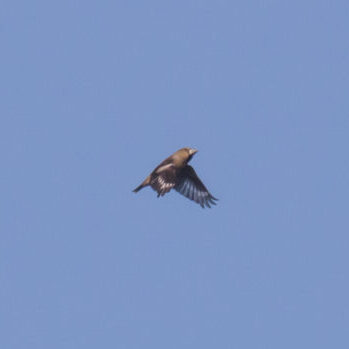No-one was more ready for a Hawfinch flyover than me. I had refreshed my search image of flying birds and I had listened to recordings of flight calls on a daily basis.

I had also refined my flight call sound recording technique, positioning my recorder with the microphone pointing straight up, a meter or so from where I stood, watching the sky. This enabled me to review interesting flight calls and capture the important ones. And still they nearly got past me.
I had been out watching and listening to bird migration for the first hour of light pretty much every day for the last week. Reports of Hawfinches passing over local sites kept me motivated, but after a combined total of about eight hours of watching I was beginning to wonder if any were ever going fly over this small, green patch of urban Oxford.
At 7:15am on Tuesday 30th October, after about half an hour of watching and listening to light overhead bird migration, I heard a series of sharp, high-pitched flight calls, from above and almost behind me. They sounded a bit like a Meadow Pipit calling whilst 1,000 volts were being passed through it. Or more accurately, a repeated high-pitched “tsick“.
I whirled around and just got onto the source of the calls: two large, short-tailed finches that flew low and fast away from me, disappearing over the trees on Hill Top Road, to the west. No real plumage details could be made out but all my instincts were that those birds were probably Hawfinches. Now it was down to the sound recorder to confirm the identification.
Fortunately, my recorder had picked up the flight calls, even over the sounds of a local dog walker passing by and the banging of building work at the Warneford Hospital site. The calls are classic Hawfinch flight calls, an inverted v-shaped call at the 7-9 kHz range. Typical Hawfinch, completely distinctive, yet somehow easy to overlook.
The last big Hawfinch year, the winter of 2017/18, was just before I began regularly watching the Lye Valley area. Phil Barnett found a small flock of Hawfinches in the Lye Valley woods in February 2018. I wondered how it would ever be possible to see this elusive species here again? Fortunately, this year’s irruption of Hawfinches from continental Europe has provided just that opportunity. Species number 111 for the Lye Valley bird list and for me!

